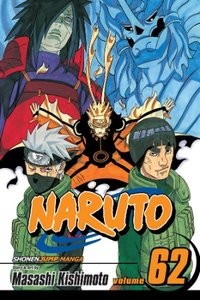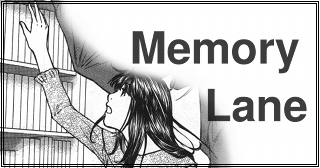RIGHT TURN ONLY!!
Gift of the Magi
by Carlo Santos,

It's already the end of August? Kids are going back to school? Where did summer even go?! Conventions have a way of eating up your weekends, and then there are the "normal people" activities that you get roped into, and suddenly the days are getting shorter again and the heat just hangs in the air and—boom!—that's where summer went, and it's not ever coming back.
DOROHEDORO

Vol. 10
(by Q Hayashida, Viz Media, $12.99)
FROM THE BACK COVER:
"A dark episode unfolds by flashback in Professor Kasukabe's past, bringing him closer to the identity of the Cross-Eyes' mysteriously powerful wax doll. The amnesiac Ebisu begins to regain her memories while Caiman and Nikaido face off in a vicious battle against En. The spiral of mystery, danger, and violence leads directly back to Caiman's true identity..."
EVIDENCE FOR:
Catching up on Dorohedoro is more than just a reading experience—it's like stepping completely into a surreal sci-fi-and-magic underworld. The artwork is a big part of that surreal feeling, with sketchy penstrokes and chaotic backgrounds filling every page with tension. The character designs are also full of imagination—not just among the strangely-masked main cast, but also with the monsters that look like they've stepped out of an apocalyptic horror piece. But gruesome imagery and violent smackdowns are only half the story in this volume. Plot twists and interlocking storylines are another strong point, whether it's a crucial glimpse into Kasukabe's shady past, the dark irony of Ebisu's return to her family, or the heightened drama as a vengeful En finally catches up to lizard-headed Caiman and partner Nikaido. Who'd have thought that it'd be so shockingly easy to kill off a major character? Then again, is death ever really permanent when Sorcerers are forever messing with the laws of physics and biology? Even when something conclusive happens, this series finds a way to keep people guessing...
EVIDENCE AGAINST:
Dorohedoro continues to disappoint in the usual ways. It juggles too many characters, jumps haphazardly between subplots, and gets in the way of itself with overly ambitious visuals. Yes, Kasukabe's flashback strikes a poignant chord and connects to a major plot point—but it's never mentioned again after the first couple of chapters. (Such is the fate of supporting characters who get a moment in the spotlight.) Ebisu's homecoming journey takes a similar turn: it's engrossing and action-packed, but is deemed irrelevant as soon as it finds a place to stop. Beyond that, the overlapping storylines keep piling up: Caiman and Nikaido's endless road trip, En's quest for revenge, and the activities of the Cross-Eyes gang. Is it any wonder that this series can never find a good moment to cut between scenes? Instead, it leaves everything hanging. The artwork during action scenes is also dangerously confusing, with too many details, special effects, and combatants trying to jump into every single panel. Sometimes the trick with great visuals is knowing what not to draw.
FINAL VERDICT:
Another case of having great ideas but not-so-great execution. Although this volume hits some key plot points, the shaky storytelling earns it a C.
MAGI

Vol. 1
(by Shinobu Ohtaka, Viz Media, $9.99)
FROM THE BACK COVER:
"Deep within the deserts lie the mysterious Dungeons, vast stores of riches there for the taking by anyone lucky enough to find them and brave enough to venture into the depths from where few have ever returned. Plucky young adventurer Aladdin means to find the Dungeons and their riches, but Aladdin may be just as mysterious as the treasures he seeks.
Together with the djinn UGO and his friend Alibaba, Aladdin sets out to find his fortune in the depths of the endless dunes..."
EVIDENCE FOR:
Magi is adventure in its purest form, speeding from one peril to the next as if the heroes' lives depended on it. Actually, their lives do depend on it—this story's got sword-wielding bandits, ruthless merchants, and unreal monsters lurking in the Dungeons, so every encounter might be their last! But the characters' inner motivations also matter; the early chapters portray Aladdin and Alibaba as heroes who stand up for what's right and help the downtrodden. These guys aren't afraid to wear their emotions on their sleeves, showing pain, anger, and determination as they combat an unjust society. But enough with the politics—this volume shines most when magic, exploration, and fighting come into play. It's a thrill ride every time Aladdin summons UGO, with his giant muscular limbs popping out and smashing their way through danger. Alibaba doesn't have such fancy tools at his disposal, but he makes the most out of frenetic hand-to-hand combat scenes and chase sequences. Sweeping curves and dramatic angles create a genuine sense of motion, while carefully drawn artifacts and background art add to the ambiance of Magi's mysterious world.
EVIDENCE AGAINST:
Like many adventure series, Magi gets the surface details right, but seems to lack a solid core. Aladdin shows up out of thin air, and any attempts to explain his origin lack substance: three flashback panels in the first chapter, a vague conversation with Alibaba, and not much else. Of course, it's not like Alibaba has much of a back-story either: he's just there one day, crossing paths with Aladdin and deciding to join forces. Furthermore, the idea that the Dungeons suddenly started appearing around the world a decade and a half ago (instead of, say, having lain undiscovered for centuries) makes them sound like contrived theme-park contraptions instead of mysterious lairs of magic. The urgent pace of the series—always rushing ahead to the next fight scene—also leaves little room to flesh out any story details. The artwork may seem like a rush job as well: more careful shading and toning would have helped in adding to the realism of this world, and some scenes get so caught up in the action that there are no places for the eye to rest.
FINAL VERDICT:
The constant action and elaborate world-building are enough to get fans hooked, but the story still needs to fill in more details. This debut volume ranks a B-.
MISSIONS OF LOVE

Vol. 4
(by Ema Toyama, Kodansha Comics, $10.99)
FROM THE BACK COVER:
"Now that she's back after a long sick leave, Mami Mizuno, the girl every boy in school has a crush on, never leaves Shigure's side. Never, that is, except for when she's pestering Yukina. She claims to want to help Yukina win Shigure's heart, but what is she really after?"
EVIDENCE FOR:
Could it be? The love triangle is turning into ... a love diamond? Yes, Mami is the newest obstacle in Yukina and Shigure's seesaw relationship—and like every character in this manga, she manages to be both infuriating and fascinating. Behind Mami's sweet, bubbly exterior lies a scheming temptress, one whose manipulative plans create plenty of tension. However, the most exciting, heart-thumping situations in this volume are still the ones Shigure and Yukina get into all by themselves. The premise of "I order you to act out this love scene so that I can write my online novel" is still in effect, and it leads the main couple into some decidedly steamy (but still teen-rated) poses—a little neck contact, a longing embrace, even a touch upon the lips. Yet these gestures would mean nothing without the swirling mind games and emotional tug-of-war being played between everyone. The artwork focuses heavily on the characters' expressions and how they physically interact—a smart decision that adds intensity to every scene. Various screentone patterns also enhance the visuals: a grim shadow or a sparkling effect can say plenty about a character's emotional state at that moment.
EVIDENCE AGAINST:
Some of these missions are just getting absurd. Even if it's all just fantasy novel play-acting, the "vampire attacks" and "healing spells" are just an excuse to place two characters in a sensual position. In fact, in the last scene—where there's no mission involved—Shigure does something to Yukina that seriously crosses the line. There's a delicate balance between romantic and reprehensible, and Missions of Love may have stumbled here. The sheer luck required to set up some of the situations is also ridiculous: somehow, these kids are able to find an unoccupied classroom right when they need it, and they always meet up to have important conversations without ever getting sidetracked. Plus, Yukina and Shigure keep rehashing the same conversation: do they really like each other or not? Meanwhile, the school setting continues to highlight the series' artistic weaknesses: it's hallways, classrooms, and courtyards as far as the eye can see. Frequent close-ups on the characters' faces, and panel layouts that leave little breathing room, also create a messy appearance.
FINAL VERDICT:
The melodrama runs high in this volume, which can be both good and bad. Some situations may be hard to believe—but the suspense and emotions are real enough to earn a B+.
NARUTO

Vol. 62
(by Masashi Kishimoto, Viz Media, $9.99)
FROM THE BACK COVER:
"Naruto is a young shinobi with an incorrigible knack for mischief. He's got a wild sense of humor, but Naruto is completely serious about his mission to be the world's greatest ninja!
With Itachi having stopped Kabuto, it's time for the Edotensei warriors to finally be returned to the afterlife! This means that Itachi's time on earth will also be coming to an end. How will Sasuke deal with losing his brother once again? And what dark tricks does Madara have up his sleeve?!"
EVIDENCE FOR:
Naruto covers plenty of ground in this volume, with big plot advancements and major mood swings. The end of Itachi and Sasuke's fight against Kabuto is a highlight, with lots of drama between the two brothers—Sasuke still clings to his vendetta against Konoha Village, while Itachi recounts his ill-fated choices in life. The most powerful moment of all comes when one of them makes an honest confession. Meanwhile, Naruto, Kakashi, and Guy are caught up in another battle, and this time it's the series' tactical side that shines. How do you strike a ninja who can pass through any solid object? Kakashi's analysis of the problem—followed by a brilliant, action-packed solution—is proof that even a fighting series can be intellectually stimulating. Of course, there's visual stimulation as well, with summoned beasts dealing out gargantuan attacks, whole mountains being leveled, and high-speed moves broken down into intricate freeze-frame sequences. And the artistic variety doesn't stop there: there's a touch of the grotesque when Sasuke revives a long-dead foe, and conversely, some mind-bending diagrams when Kakashi stops to explain ninja physics.
EVIDENCE AGAINST:
Sadly, Naruto still can't escape all the extraneous fluff that pads out this epic ninja war. The Five Kage, bless their hearts, are supposed to be the best of the best—yet their battle is an uninspired waste of time. They're completely outmatched right now, none of their attacks are accomplishing anything, and their idea of powering up is to remind themselves, "We've got to fight hard for Naruto!" Self-affirmation may be an important part of succeeding in life, but it makes for lousy storytelling. Sasuke's discussion of his next move is another sinkhole in this volume: he simply gathers his minions together, and they talk at length about how to acquire information that will help in bringing down Konoha. Naruto and Kakashi fall into a similar dialogue trap when discussing their opponent's methods. The artwork, meanwhile, is crammed with too much detail Yet Again: anything ranging from excessive speedlines that clash with the foreground, to hand-drawn shading on every single rock and patch of soil. Better use of screentones would probably have helped to clarify the visuals.
FINAL VERDICT:
This volume has some promising moments in this volume—Sasuke and Itachi's heart-to-heart conversation, and then the intricacy of Naruto's fight. But drag-out moments and visual clutter add up to a C+.
PUELLA MAGI ORIKO MAGICA

Vol. 1
(by Magica Quartet and Mura Kuroe, Yen Press, $11.99)
FROM THE BACK COVER:
"Oriko, a magical girl with the gift of foresight, knows the fate that awaits all who accept Kyubey's offer of supernatural powers. But when she is struck with a terrible vision of the future—of the devastation caused by a single, powerful witch—she decides to prevent the girl from becoming a magical girl in the first place. To draw Kyubey away from the girl's potential, Oriko directs him instead to Yuma, an orphan who is all too eager to gain powers that will enable her to protect herself—powers that will ultimately lead to her own destruction..."
EVIDENCE FOR:
For fans who want to revisit the Madoka Magica universe, but don't want to go as far afield as the brand-new characters of Kazumi Magica, there's Oriko Magica, which recasts the original five in a spinoff story. It's every bit as dramatic as the original, if not more so: there's a bloody parental death in the very first chapter, limbs being dismembered, and a magical-girl serial killer on the loose. But the real pain comes when Pocky-chomping Kyouko takes little Yuma under her wing: seeing these fragile characters form a bond, despite the odds so heavily stacked against them, cuts right to the heart. The story takes another wicked twist in the volume's last chapter, when fan-favorite Mami shows up and puts her life on the line as she investigates the serial-killer mystery. The energetic artwork makes the most out of the magical-girl-versus-witch battles, with tightly angled poses, plenty of special effects, and a fair share of bloodshed. The distinctly grotesque witches also add to the visual impact.
EVIDENCE AGAINST:
Among the titles in the Madoka Magica manga family, this is the weakest of the bunch. Kyouko and Mami probably deserved a better story for their first starring role. This tale substitutes violence and excessive tragedy for true drama, like Yuma's parents being both abusive and deceased—that's practically a double-cliché bingo. Then there's the poorly explained mystery surrounding Oriko and her accomplice Kirika. The title character is obviously up to something, but she barely participates in the action aside from making ominous plans and (at one point) having an inexplicable tea party. How about getting into the game, instead of just tiptoeing around the edges of the storyline? The real disservice to the franchise, though, is the artwork. I'm not saying that the character designs need to be 100% accurate, but this manga's style looks like a "Moe Gone Wrong" drawing manual, warping the original characters beyond recognition. Their features are too exaggerated, with wide, saucer-like eyes, wild explosions of hair, and putty cheeks. Meanwhile, heavy gradient screentones make a mess of the backgrounds, and the page layouts jump from one overexcited panel to another with no sense of flow.
FINAL VERDICT:
This is not the Madoka spinoff you're looking for. Between the sloppy artwork and melodramatic storyline, it's a straight-out D for this volume.

YAMADA-KUN TO NANA-NIN NO MAJO (YAMADA-KUN AND THE 7 WITCHES)

Vol. 1
(by Miki Yoshikawa, Kodansha, ¥440)
FROM THE BACK COVER:
"Suzaku High School's number one problem child, Ryū Yamada, is in a foul mood after being scolded by his teacher Yet Again. Worse yet, he trips down a staircase and crashes into honor student urara Shiraishi—and now he's dead! Or so he thinks. Instead, Yamada wakes up to find that he's switched bodies with Shiraishi! Now the school's two most incompatible personalities must make it through the day. And to think, it all started with a (totally accidental) kiss!"
EVIDENCE FOR:
It's a cliché these days to call a teen comedy "smart and sassy," but that's exactly what Yamada-KUN is. Between Yamada's hot-tempered antics and Shiraishi's ice-cold demeanor, the main characters alone have enough attitude to carry the entire storyline. Their body-switching adventures result in plenty of witty observations on school life: the subtle harrassment faced by so many female students, the fickle dynamics of friendship and popularity, and how stupidly easy it is to game the standardized-testing system. But there's more fun in store when other students step into Yamada and Shiraishi's circle: the next few chapters contain absurd schemes, secret plots, and unfortunate coincidences just waiting to happen. The sharp comedic timing isn't merely a product of the characters' actions, but also the visual layouts—well-placed page turns and panel spacing are what make these punchlines work. Meanwhile, a couple of convincing fight scenes also add some hot-blooded action to the story. Unique character designs make it easy to get familiar with the cast, while crisp lines and shading keep the artwork looking clean.
EVIDENCE AGAINST:
Yamada-KUN may be smart, but it's not that smart. The series still uses plenty of overdone comedy tropes, starting with the story premise itself: Fall down the stairs and weird things magically happen! Then come all the predictable comedy tricks, like someone walking in on an uncomfortable scene, or Yamada (as Shiraishi) faking his way through a girls-only situation, and of course the exasperating "Wow, let me check out my own body!" gag. The individual chapters also pull ideas straight out of the teen-comedy playbook: taking an exam, going on a date, getting changed for gym, or starting a club (with ulterior motives in mind). Furthermore, it's a bit disappointing to see controversial ideas from the first chapter—namely, sexism and bullying—get pushed to the side in favor of sillier topics like trying to sneak into your counterpart's house. Sure, the goal of the series is to entertain its audience—but if it could do that while also provoking some serious thought, then it'd really be a work of genius.
FINAL VERDICT:
Although it recycles certain school-comedy scenarios, the first volume is greater than the sum of its parts. With highly entertaining characters and a fertile ground for wacky adventures, what's not to like?

TACTICS

(by Kazuko Higashiyama and Sakura Kinoshita, ADV Manga/Tokyopop)
You know what's more depressing than a manga getting licensed then having the company go under? Getting licensed twice and having both companies go under. That's the fate that befell Tactics, which originally came out from ADV Manga, got rescued by Tokyopop, and was finally hung out to dry after Tokyopop gave up on dead-tree publishing. It's a shame, because this series has the makings of a fan favorite: a strong grounding in Japanese folklore, supernatural mysteries and battles, character-driven comedy, and a hint of BL just for kicks. The lead character is Kantaro, an adorable, shota-styled lad who researches the mystical world of yokai with help from his tall, handsome, and demonic companion Haruka. A feisty fox-girl named Yoko rounds out the main cast, and together their adventures range anywhere from single-chapter trifles to epic, world-threatening drama. (Especially when Haruka's dark side comes into play...)
The elegantly-styled artwork tries its best to bridge different genres and demographics: the lines are delicate and crisp, yet there are enough bold action scenes and mystical phenomena to fulfill the dark-and-dangerous quota. What's more, the visual contrast between Kantaro's innocent looks and Haruka's bad-boy demeanor serves as perfect BL bait. The plot gets more serious and complicated as the volumes progress, but that doesn't stop the series from occasionally cutting loose with some light humor, or telling shorter stories that put a twist on traditional yokai tales.
The good news is that Tactics hasn't been completely wiped from English-speaking manga bookshelves: online and used-book retailers still have old Tokyopop copies to spare, and (surprise, surprise!) a third party has digitized it into Kindle format. But any hope that a kindly soul will pick up after Volume 8—where the last licensor left off—is slim.
discuss this in the forum (8 posts) |